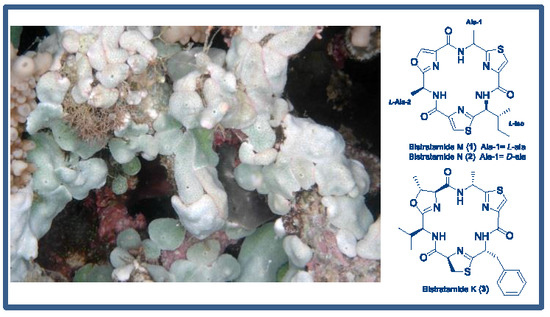Bistratamides M and N, Oxazole-Thiazole Containing Cyclic Hexapeptides Isolated from Lissoclinum bistratum Interaction of Zinc (II) with Bistratamide K
Abstract
:1. Introduction
2. Results and Discussion
2.1. Isolation and Structure Elucidation
2.2. Interaction Studies of Zinc (II) with Bistratamide K
3. Materials and Methods
3.1. General Experimental Procedures
3.2. Animal Material
3.3. Extraction and Isolation
3.4. Absolute Configuration
3.5. Titration of Bistratamide K (3)
3.6. Biological Assays
4. Conclusions
Supplementary Materials
Acknowledgments
Author Contributions
Conflicts of Interest
References
- Degnan, B.M.; Hawkins, C.J.; Lavin, M.F.; McCaffrey, E.J.; Parry, D.L.; Watters, D.J. Novel Cytotoxic Compounds from the Ascidian Lissoclinum bistratum. J. Med. Chem. 1989, 32, 1354–1359. [Google Scholar] [CrossRef] [PubMed]
- Mark, P.F.; Gisela, P.C.; Gina, B.C.; Ireland, C.M. Bistratamides C and D. Two new oxazole-containing cyclic hexapeptides isolated from a Philippine Lissoclinum bistratum ascidian. J. Org. Chem. 1992, 57, 6671–6675. [Google Scholar]
- Perez, L.J.; Faulkner, D.J. Bistratamides E–J, Modified Cyclic Hexapeptides from the Philippines Ascidian Lissoclinum bistratum. J. Nat. Prod. 2003, 66, 247–250. [Google Scholar] [CrossRef] [PubMed]
- Hambley, T.W.; Hawkins, C.J.; Lavin, M.F.; Van den Brenk, A.; Watters, D.J. Cycloxazoline: A cytotoxic cyclic hexapeptide from the ascidian Lissoclinum bistratum. Tetrahedron 1992, 48, 341–348. [Google Scholar] [CrossRef]
- Prinsep, M.R.; Moore, R.E.; Levine, I.A.; Patterson, G.M. Westiellamide, a bistratamide-related cyclic peptide from the blue-green alga Westiellopsis prolifica. J. Nat. Prod. 1992, 55, 140–142. [Google Scholar] [CrossRef] [PubMed]
- Foster, M.P.; Ireland, C.M. Nairaiamides A and B. Two Novel Di-Proline Heptapeptides Isolated from a Fijian Lissoclinum bistratum Ascidian. Tetrahedron Lett. 1993, 34, 2871–2874. [Google Scholar] [CrossRef]
- Schmitz, F.J.; Ksebati, M.B.; Chang, J.S.; Wang, J.L.; Hossain, M.B.; van der Helm, D.; Engel, M.H.; Serban, A.; Silfer, J.A. Cyclic Peptides from the Ascidian Lissoclinurn patella: Conformational Analysis of Patellamide D by X-ray Analysis and Molecular Modeling. J. Org. Chem. 1989, 54, 3463–3472. [Google Scholar] [CrossRef]
- Ireland, C.M.; Durso, A.R.; Newman, R.A.; Hacker, M.P. Antineoplastic Cyclic Peptides from the Marine Tunicate Lissoclinurn patella. J. Org. Chem. 1982, 47, 1807–1811. [Google Scholar] [CrossRef]
- McDonald, L.A.; Foster, M.P.; Phillips, D.R.; Ireland, C.M. Tawicyclamides A and B, New Cyclic Peptides from the Ascidian Lissoclinum patella: Studies on the Solution- and Solid-state Conformation. J. Org. Chem. 1992, 57, 4616–4624. [Google Scholar] [CrossRef]
- Crawford, J.M.; Clardy, J. Bacterial symbionts and natural products. Chem. Commun. 2011, 47, 7559–7566. [Google Scholar] [CrossRef] [PubMed]
- Lewin, R.; Chang, L. Prochloron: A Microbial Enigma; Chapman and Hall: New York, NY, USA, 1989. [Google Scholar]
- Milne, B.F.; Long, P.F.; Starcevic, A.; Hranueli, D.; Jaspars, M. Spontaneity in the patellamide biosynthetic pathway. Org. Biomol. Chem. 2006, 4, 631–638. [Google Scholar] [CrossRef] [PubMed]
- Houssen, W.E.; Bent, A.F.; McEwan, A.R.; Pieiller, N.; Tabudravu, J.; Koehnke, J.; Mann, G.; Adaba, R.I.; Thomas, L.; Hawas, U.W.; et al. An Efficient Method for the In Vitro Production of Azol(in)e-Based Cyclic Peptides. Angew. Chem. 2014, 53, 14171–14174. [Google Scholar] [CrossRef] [PubMed]
- Comba, P.; Dovalil, N.; Gahan, L.R.; Hanson, G.R.; Westphal, M. Cyclic peptide marine metabolites and CuII. Dalton Trans. 2014, 43, 1935–1956. [Google Scholar] [CrossRef] [PubMed]
- Bertram, A.; Pattenden, G. Marine metabolites: Metal binding and metal complexes of azole-based cyclic peptides of marine origin. Nat. Prod. Rep. 2007, 24, 18–30. [Google Scholar] [CrossRef] [PubMed]
- Bertram, A.; Maulucci, N.; New, O.M.; Mohd Nor, S.M.; Pattenden, G. Synthesis of libraries of thiazole, oxazole and imidazole-based cyclic peptides from azole-based amino acids. A new synthetic approach to bistratamides and didmolamides. Org. Biomol. Chem. 2007, 5, 1541–1553. [Google Scholar] [CrossRef] [PubMed]
- Garcia, A.; Lenis, L.A.; Jiménez, C.; Debitus, C.; Quiñoá, E.; Riguera, R. The Occurrence of the Human Glycoconjugate C2-α-d-Mannosylpyranosyl-l-tryptophan in Marine Ascidians. Org. Lett. 2000, 2, 2765–2767. [Google Scholar] [CrossRef] [PubMed]
- Jiménez, C.; Quiñoá, E.; Castedo, L.; Riguera, R. Epidioxy Sterols from the Tunicates Dendrodoa grossularia and Ascidiella aspersa and the Gastropoda Aplysia depilans and Aplysia punctata. J. Nat. Prod. 1986, 49, 905–909. [Google Scholar] [CrossRef]
- Marfey, P. Determination of d-amino acids. II. Use of a bifunctional reagent, 1,5-difluoro-2,4-dinitrobenzene. Carlsberg Res. Commun. 1984, 49, 591–596. [Google Scholar] [CrossRef]
- Harada, K.; Fujii, K.; Hayashi, K.; Suzuki, M.; Ikai, Y.; Oka, H. Application of d,l-FDLA derivatization to determination of absolute configuration of constituent amino acids in peptide by advanced Marfey’s method. Tetrahedron Lett. 1996, 37, 3001–3004. [Google Scholar] [CrossRef]
- Urda, C.; Pérez, M.; Rodríguez, J.; Jiménez, C.; Cuevas, C.; Fernández, R. Pembamide, a N-methylated linear peptide from a sponge Cribrochalina sp. Tetrahedron Lett. 2016, 57, 3239–3242. [Google Scholar] [CrossRef]
- Banker, R.; Carmeli, S. Tenuecyclamides A–D, Cyclic Hexapeptides from the Cyanobacterium Nostoc spongiaeforme var. tenue. J. Nat. Prod. 1998, 61, 1248–1251. [Google Scholar] [CrossRef] [PubMed]
- Ojika, M.; Nemoto, T.; Nakamura, M.; Yamada, K. Dolastatin E, a new cyclic hexapeptide isolated from the sea hare Dolabella auricularia . Tetrahedron Lett. 1995, 36, 5057–5058. [Google Scholar] [CrossRef]
- Michael, J.P.; Pattenden, G. Marine Metabolites and Metal Ion Chelation: The Facts and the Fantasies. Angew. Chem. 1993, 32, 1–23. [Google Scholar] [CrossRef]
- Ngyen, H.; Orlamuender, M.; Pretzel, D.; Agricola, I.; Sternberg, U.; Reissmann, S. Transition metal complexes of a cyclic pseudo hexapeptide: Synthesis, complex formation and catalytic activities. J. Pept. Sci. 2008, 14, 1010–1021. [Google Scholar] [CrossRef] [PubMed]
- Comba, P.; Eisenschmidt, A.; Gahan, L.R.; Hanson, G.R.; Mehrkens, N.; Westphal, M. Dinuclear ZnII and mixed CuII–ZnII complexes of artificial patellamides as phosphatase models. Dalton Trans. 2016, 45, 18931–18945. [Google Scholar] [CrossRef] [PubMed]
- Comba, P.; Dovalil, N.; Haberhauer, G.; Hanson, G.R.; Kato, Y.; Taura, T.J. Complex formation and stability of westiellamide derivatives with copper (II). Biol. Inorg. Chem. 2010, 15, 1129–1135. [Google Scholar] [CrossRef] [PubMed]
- Urda, C.; Gómez, E.; Reyes, F.; García-Cerezo, A.; Tanaka, J.; de Eguilior, C.; Bueno, S.; Cuevas, C. Bistratamides K-N, Four New Thiazole-containing Cyclic Hexapeptides from the Ascidian Lissoclinum bistratum. Proceedings of 14th Symposium on Marine Natural Product/8th European Conference on Marine Natural Products, La Toja Island, Galicia, Spain, 15–20 September 2013. p. 184/p. 249. The 1D (1H and 13C NMR) and 2D (COSY, HSQC, HMBC) NMR spectra of bistratamide K (3) along with its proton and carbon chemical shifts data and a figure displaying the key HMBC correlations are enclosed in the supporting material. [Google Scholar]
- Comba, P.; Gahan, L.R.; Haberhauer, G.; Hanson, G.R.; Noble, C.J.; Seibold, B.; van den Brenk, A.L. Copper (II) Coordination Chemistry of Westiellamide and Its Imidazole, Oxazole, and Thiazole Analogues. Chem. A Eur. J. 2008, 14, 4393–4403. [Google Scholar] [CrossRef] [PubMed]
- Van den Brenk, A.L.; Fairlie, D.P.; Gahan, L.R.; Hanson, G.R.; Hambley, T.W. A novel potassium-binding hydrolysis product of ascidiacyclamide: A cyclic octapeptide isolated from the ascidian Lissoclinum patelIa. Inorg. Chem. 1996, 35, 1095–1110. [Google Scholar] [CrossRef] [PubMed]
- Grøndahl, L.; Sokolenko, N.; Abbenante, G.; Fairlie, D.P.; Hanson, G.R.; Gahan, L.R. Interaction of zinc (II) with the cyclic octapeptides, cyclo[Ile(Oxn)-d-Val(Thz)]2 and ascidiacyclamide, a cyclic peptide from Lissoclinum patella. J. Chem. Soc. Dalton Trans. 1999, 1227–1234. [Google Scholar] [CrossRef]
- Skehan, P.; Storeng, R.; Scudiero, D.; Monks, A.; McMahon, J.; Vistica, D.; Warren, J.T.; Bokesch, H.; Kenney, S.; Boyd, M.R. New Colorimetric Cytotoxicity Assay for Anticancer-Drug Screening. J. Natl. Cancer Inst. 1990, 82, 1107–1112. [Google Scholar] [CrossRef] [PubMed]
- Shoemaker, R.H. The NCI60 human tumour cell line anticancer drug screen. Nat. Rev. Cancer 2006, 6, 813–823. [Google Scholar] [CrossRef] [PubMed]
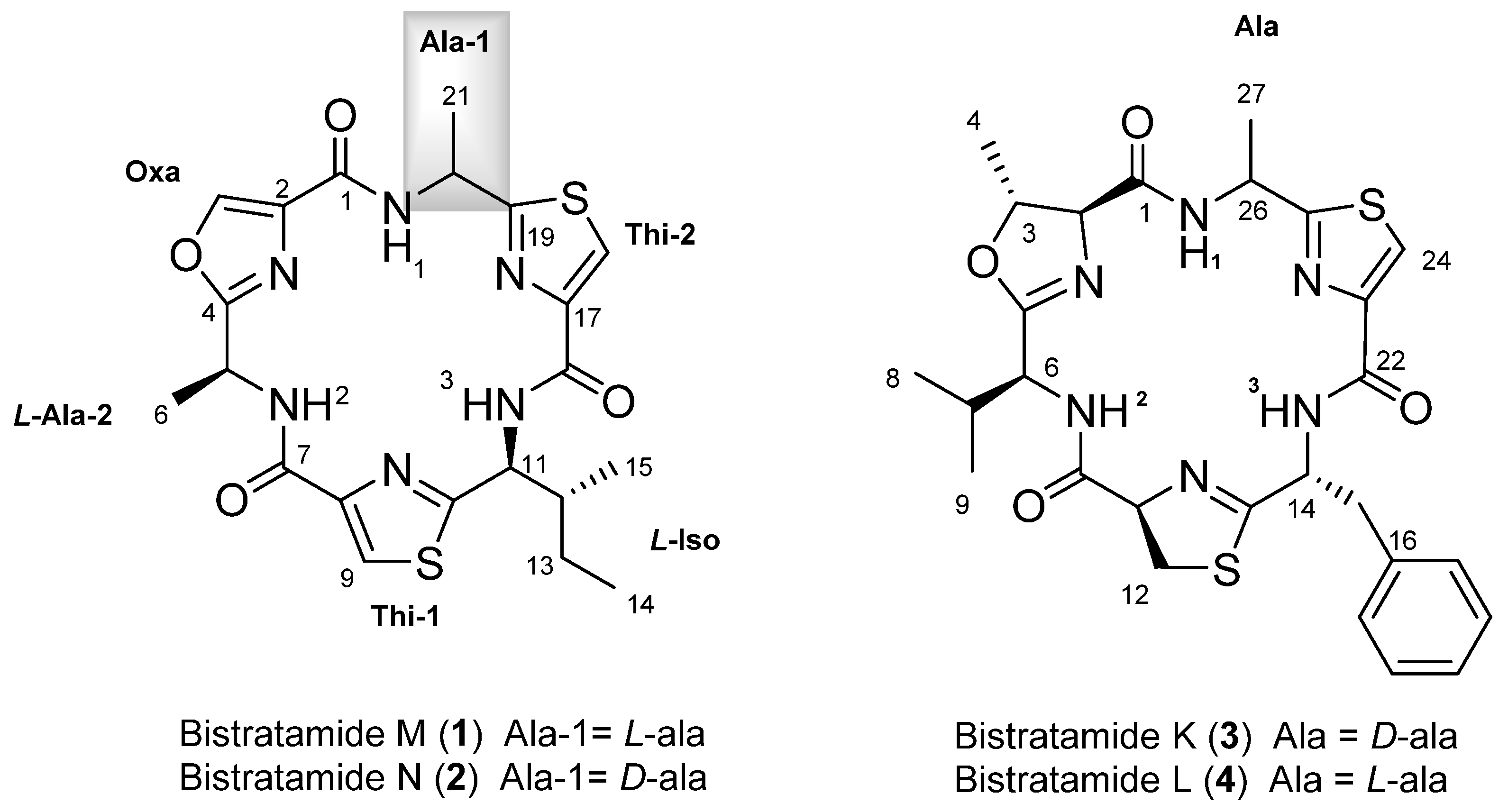
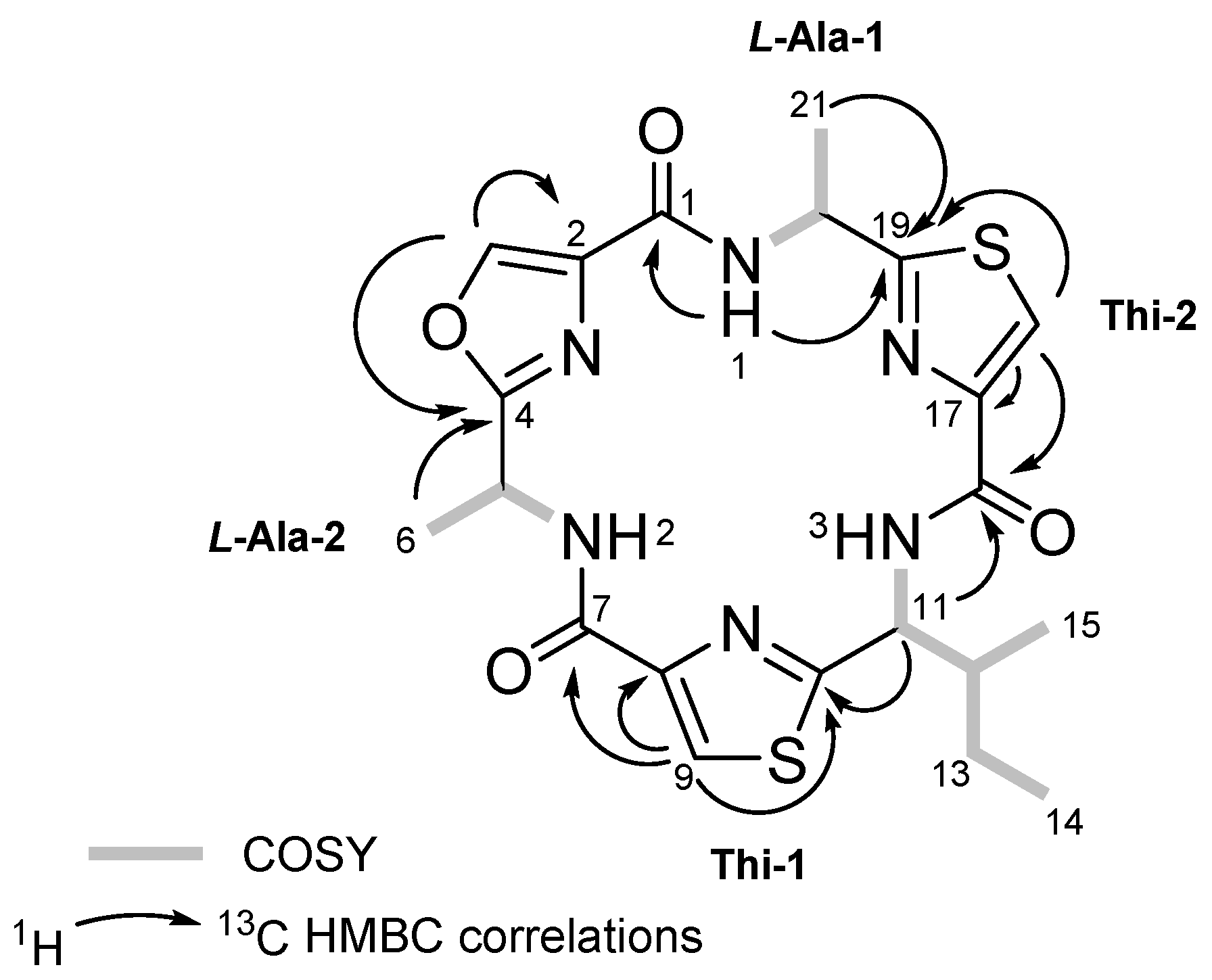
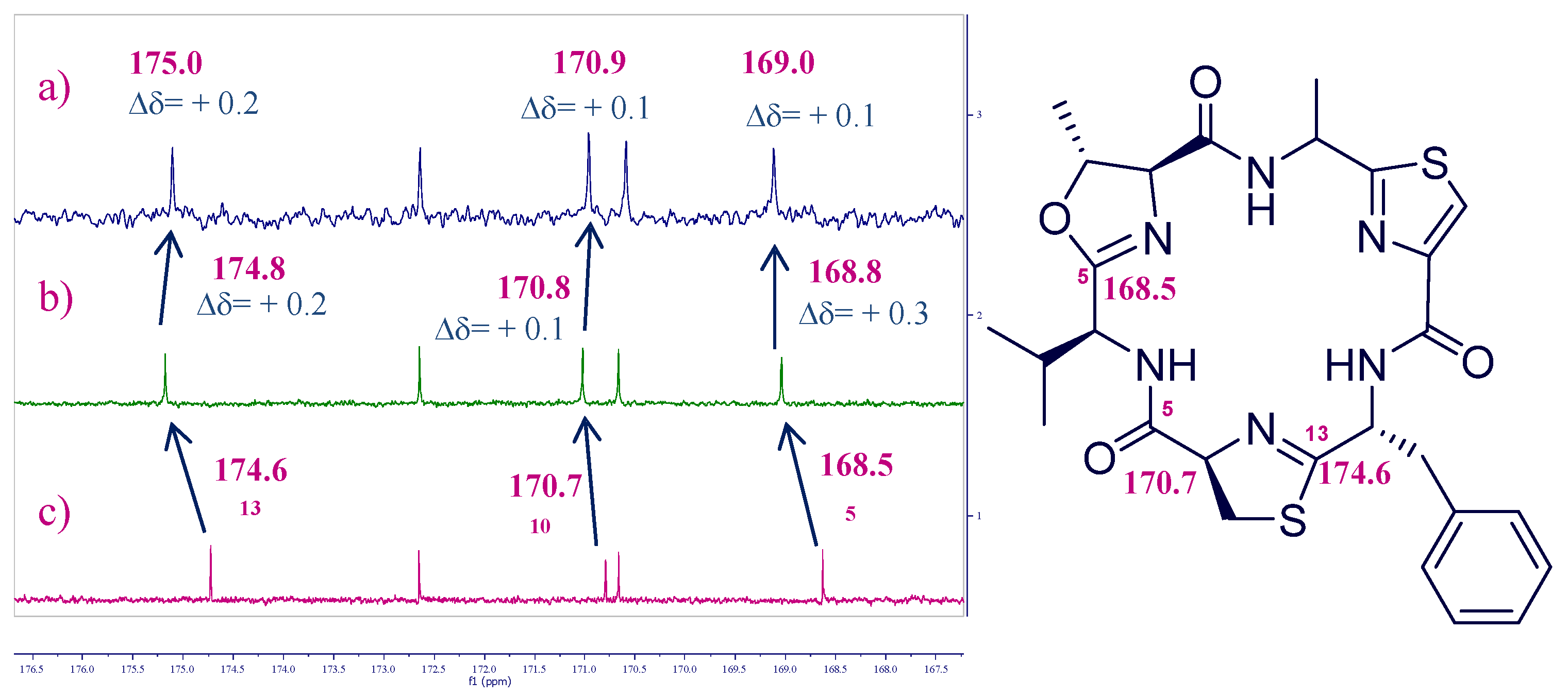
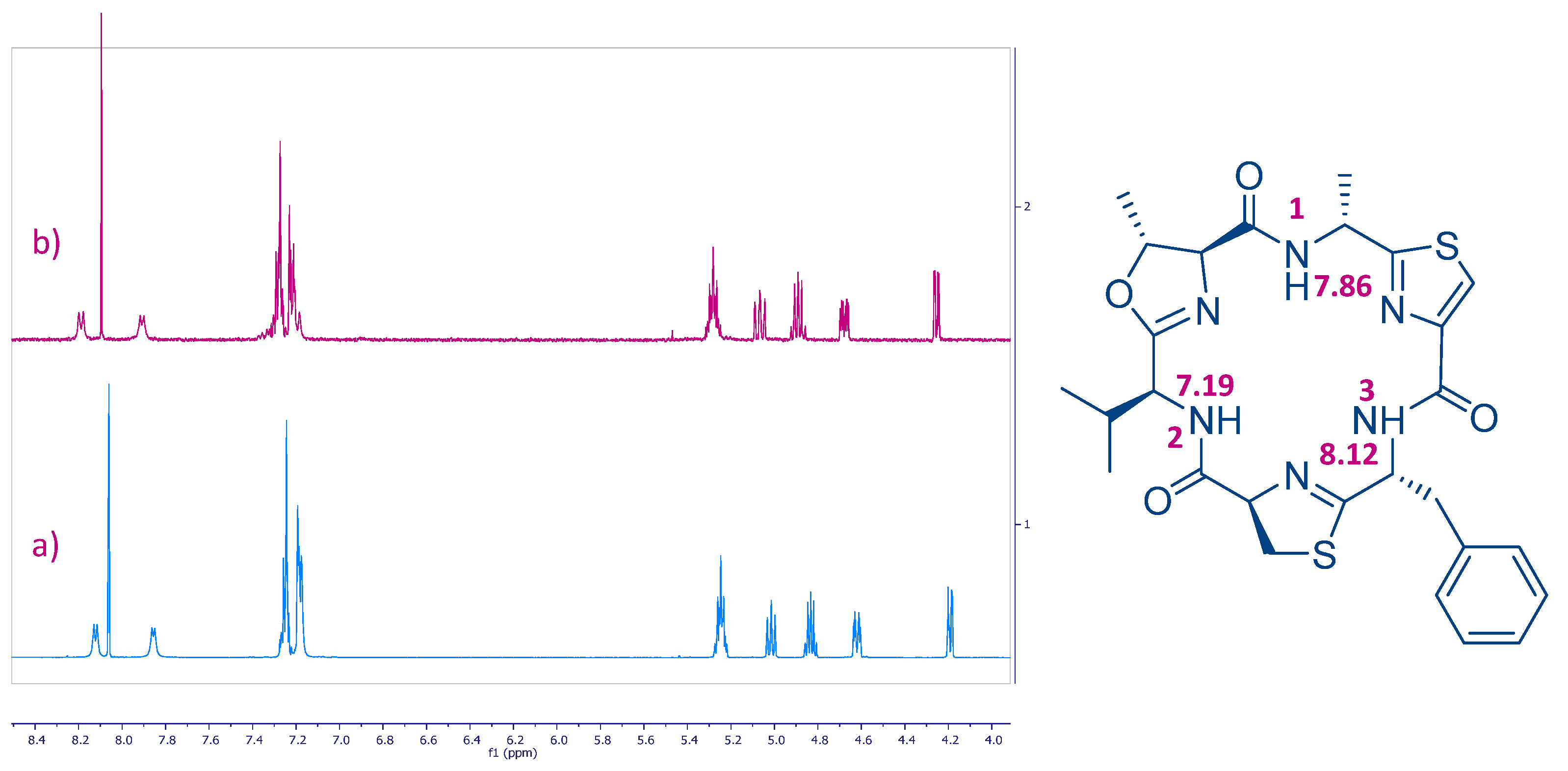
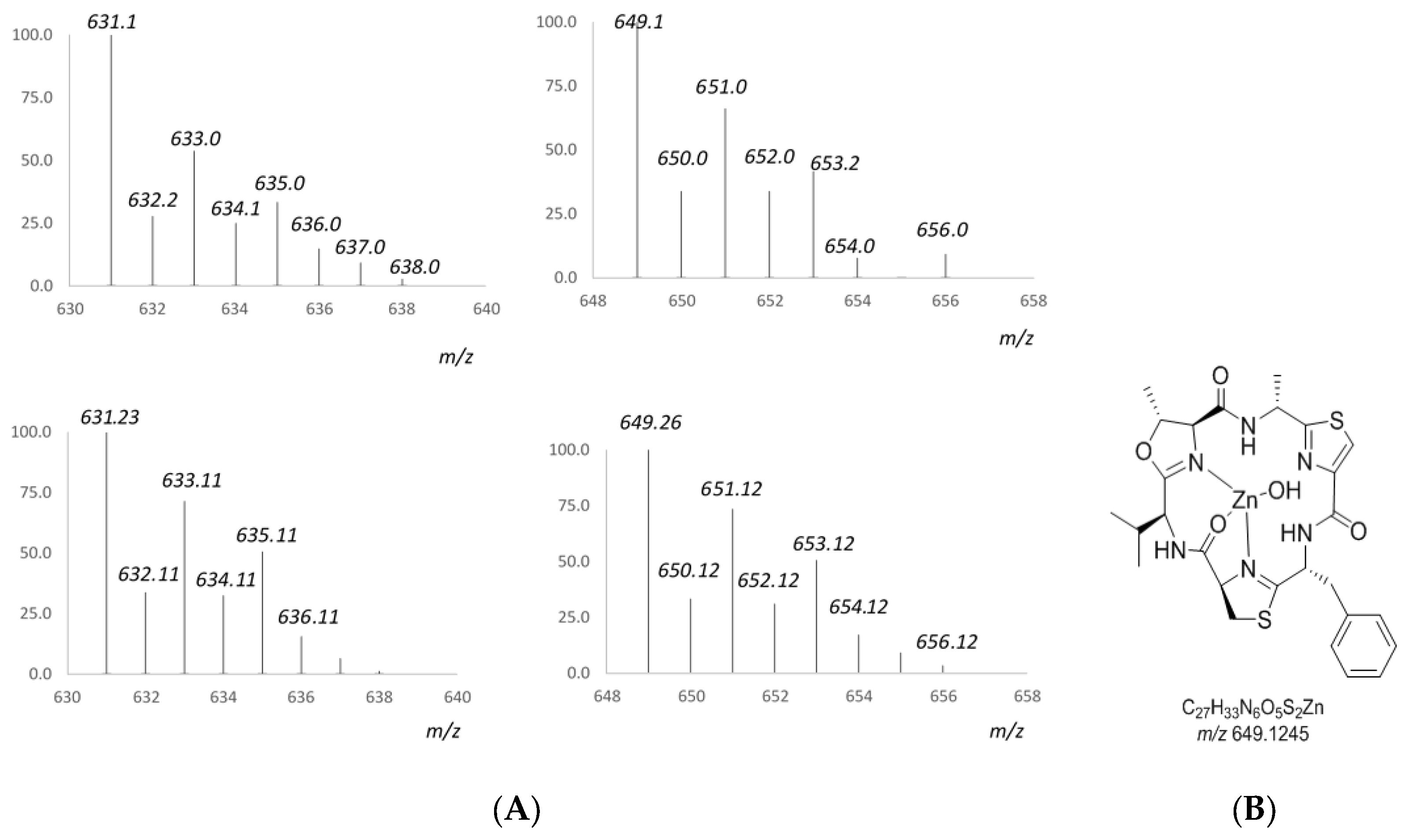
| No. | Bistratamide M (1) | Bistratamide N (2) | ||
|---|---|---|---|---|
| δC, Type | δH Mult, (J in Hz) | δC, Type | δH Mult, (J in Hz) | |
| 1 | 159.7, C | - | 159.0, C | - |
| 2 | 135.5, C | - | 135.6, C | - |
| 3 | 141.9, CH | 8.27, s | 141.5, CH | 8.23, s |
| 4 | 164.3, C | - | 164.6, C | - |
| 5 | 44.2, CH | 5.38, m | 44.1, CH | 5.37, m |
| 6 | 19.9, CH3 | 1.72, d (7.1) | 20.8, CH3 | 1.72, d (6.8) |
| 7 | 159.4, C | - | 159.5, C | - |
| 8 | 149.2, C | - | 149.1, C | - |
| 9 | 123.0, CH | 8.12, s | 123.3, CH | 8.12, s |
| 10 | 167.1, C | - | 167.9, C | - |
| 11 | 55.3, CH | 5.44, m | 54.9, CH | 5.54, m |
| 12 | 40.1, CH | 2.18, m | 41.5, CH | 2.09, m |
| 13 | 26.3, CH2 | 1.63, m; 1.24, m | 25.6, CH2 | 1.67, m; 1.32, m |
| 14 | 11.5, CH3 | 1.01, t (7.4) | 11.6, CH3 | 1.02, t (7.4) |
| 15 | 14.5, CH3 | 0.87, d (6.8) | 15.1, CH3 | 0.97, d (6.8) |
| 16 | 159.8, C | - | 159.8, C | - |
| 17 | 148.2, C | - | 148.6, C | - |
| 18 | 125.0, CH | 8.22, s | 124.3, CH | 8.17, s |
| 19 | 171.6, C | - | 171.0, C | - |
| 20 | 48.2, CH | 5.40, m | 47.7, CH | 5.46, m |
| 21 | 23.9, CH3 | 1.74, d (6.9) | 24.8, CH3 | 1.75, d (6.7) |
| NH-1 | - | 8.69, d (5.7) | - | 8.71, d (6.5) |
| NH-2 | - | 8.64, d (7.2) | - | 8.65, d (7.3) |
| NH-3 | - | 8.42, d (8.0) | - | 8.46, d (9.0) |
| Compound | Cell Line | ||||
|---|---|---|---|---|---|
| Breast | Colon | Lung | Pancreas | ||
| MDA-MB-231 | HT-29 | NSLC A-549 | PSN1 | ||
| Bistratamide M (1) | GI50 | 18 | 16.0 | 9.1 | 9.8 |
| TGI | >20.0 | >20.0 | >20.0 | >20.0 | |
| LC50 | >20.0 | >20.0 | >20.0 | >20.0 | |
| Bistratamide N (2) | GI50 | >20.0 | 13.0 | 11.0 | 15.0 |
| TGI | >20.0 | >20 | >20.0 | >20.0 | |
| LC50 | >20.0 | >20 | >20.0 | >20.0 | |
| Doxorubicin | GI50 | 0.2 | 0.3 | 0.2 | 0.2 |
| TGI | 0.5 | 0.9 | 0.9 | 0.5 | |
| LC50 | 2.4 | >17.2 | >17.2 | 3.1 | |
© 2017 by the authors. Licensee MDPI, Basel, Switzerland. This article is an open access article distributed under the terms and conditions of the Creative Commons Attribution (CC BY) license (http://creativecommons.org/licenses/by/4.0/).
Share and Cite
Urda, C.; Fernández, R.; Rodríguez, J.; Pérez, M.; Jiménez, C.; Cuevas, C. Bistratamides M and N, Oxazole-Thiazole Containing Cyclic Hexapeptides Isolated from Lissoclinum bistratum Interaction of Zinc (II) with Bistratamide K. Mar. Drugs 2017, 15, 209. https://doi.org/10.3390/md15070209
Urda C, Fernández R, Rodríguez J, Pérez M, Jiménez C, Cuevas C. Bistratamides M and N, Oxazole-Thiazole Containing Cyclic Hexapeptides Isolated from Lissoclinum bistratum Interaction of Zinc (II) with Bistratamide K. Marine Drugs. 2017; 15(7):209. https://doi.org/10.3390/md15070209
Chicago/Turabian StyleUrda, Carlos, Rogelio Fernández, Jaime Rodríguez, Marta Pérez, Carlos Jiménez, and Carmen Cuevas. 2017. "Bistratamides M and N, Oxazole-Thiazole Containing Cyclic Hexapeptides Isolated from Lissoclinum bistratum Interaction of Zinc (II) with Bistratamide K" Marine Drugs 15, no. 7: 209. https://doi.org/10.3390/md15070209







